
“Movement is life,” the roof said and left. This joke is quite “bearded”, but, like in any joke, it also has some truth. Indeed, most animals on the planet really have the ability to move. In our culture, there is even a series of metaphors, catchphrases and turns associated with animals and their movements: as fast as a cheetah; slow as a turtle; graceful, like a doe, etc. Locomotion (i.e. movement) and its individual aspects in any creature are controlled by certain body systems, from the musculoskeletal system to the central nervous system. But there are movements that scientists previously could not associate with any particular regulator. These include fading from fear. A group of researchers from Columbia University found that the serotonin we all know is responsible for the “numbness”. How did scientists come to this conclusion, why did Drosophila flies participate in the experiments, and what details were found out? We learn about this from the report of the research group. Go.
Study basis
And here again, the main hero of the study is the fruit fly, or rather the Drosophila vulgaris (Drosophila melanogaster). This is due to the fact that this seemingly unremarkable creature has a number of unique abilities, so to speak, which are very appreciated by scientists and researchers.
In order not to stretch the text, a small fact-finding paragraph about Drosophila (used in one of the previous articles) is hidden under the spoiler:
Entomology
Before sorting the report, let's get to know the main character better.

Drosophila fruit is a two-winged insect, the size of which does not exceed 2.5 mm (in females, the male is smaller). Many of us are familiar with these insects firsthand. Summer is coming, we buy fruits and vegetables, put them somewhere in the public domain and after a while notice how these little creatures have already chosen our purchases. If you do not attach importance to this, then in a few days you will have a whole army in the kitchen capable of capturing a small state. Okay, this is a hyperbole, but there are really a lot of them (I know from experience). For the development of Drosophila, much is not needed: a rather warm environment and the presence of food, which often serves as a place for laying eggs. Fruit flies feed, as the name implies, with vegetables and fruits (in the wild, the sap of trees).
The life cycle of Drosophila is quite standard: an egg (24 hours) - a larva (5 days) - a pupa (5 days) - an adult individual. Under the most favorable environmental conditions (temperature 25 ° C) the cycle takes about 10 days. That is, when you bring fruit from the store, and in a couple of days flies appear, you know - their larvae (or even eggs) were already on the products. So wash your fruits before eating.
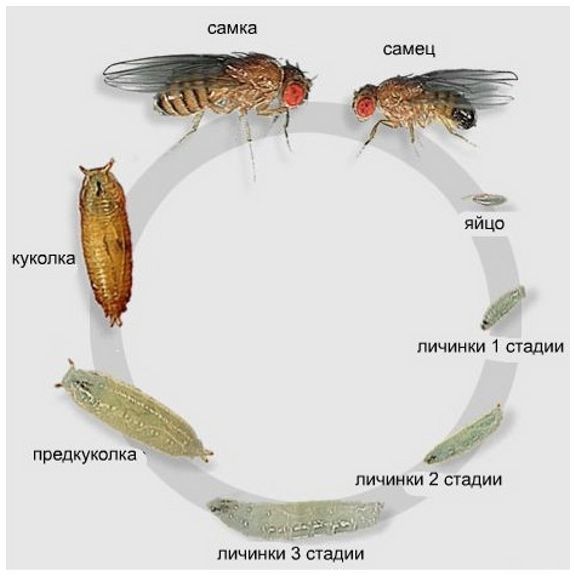
The cycle of ontogenesis of the fruit fly.
As you can see, the cycle of ontogenesis (development from an egg to an adult) does not take such a short time, but Drosophila compensate for the probability of loss of offspring during this period by the number of eggs laid. Throughout her life, the female lays about 400. At the same time, she is ready for reproduction 12 hours after the end of her ontogenesis cycle.
It would be correct to assume that Drosophila scientists are interesting not only for their ontogenesis, but also, like many insects, for their method of movement and vision. The wings of the fruit fly make about 250 flashes per second. If you find it difficult to assess how much this is, just wave your hands and see how many such movements you make. For comparison, hummingbirds (smaller species) make about 100 strokes. Also fruit flies have become an object of great interest to geneticists. The unique structural features of the Drosophila genome made it an ideal experimental in the study of human diseases (Parkinson, Alzheimer). Drosophila also help in researching the human immune system, cancer, diabetes and more.
As you can see, this little annoying creature is unique in its own way and has great potential for researchers.
Before sorting the report, let's get to know the main character better.

Drosophila fruit is a two-winged insect, the size of which does not exceed 2.5 mm (in females, the male is smaller). Many of us are familiar with these insects firsthand. Summer is coming, we buy fruits and vegetables, put them somewhere in the public domain and after a while notice how these little creatures have already chosen our purchases. If you do not attach importance to this, then in a few days you will have a whole army in the kitchen capable of capturing a small state. Okay, this is a hyperbole, but there are really a lot of them (I know from experience). For the development of Drosophila, much is not needed: a rather warm environment and the presence of food, which often serves as a place for laying eggs. Fruit flies feed, as the name implies, with vegetables and fruits (in the wild, the sap of trees).
The life cycle of Drosophila is quite standard: an egg (24 hours) - a larva (5 days) - a pupa (5 days) - an adult individual. Under the most favorable environmental conditions (temperature 25 ° C) the cycle takes about 10 days. That is, when you bring fruit from the store, and in a couple of days flies appear, you know - their larvae (or even eggs) were already on the products. So wash your fruits before eating.

The cycle of ontogenesis of the fruit fly.
As you can see, the cycle of ontogenesis (development from an egg to an adult) does not take such a short time, but Drosophila compensate for the probability of loss of offspring during this period by the number of eggs laid. Throughout her life, the female lays about 400. At the same time, she is ready for reproduction 12 hours after the end of her ontogenesis cycle.
It would be correct to assume that Drosophila scientists are interesting not only for their ontogenesis, but also, like many insects, for their method of movement and vision. The wings of the fruit fly make about 250 flashes per second. If you find it difficult to assess how much this is, just wave your hands and see how many such movements you make. For comparison, hummingbirds (smaller species) make about 100 strokes. Also fruit flies have become an object of great interest to geneticists. The unique structural features of the Drosophila genome made it an ideal experimental in the study of human diseases (Parkinson, Alzheimer). Drosophila also help in researching the human immune system, cancer, diabetes and more.
As you can see, this little annoying creature is unique in its own way and has great potential for researchers.
Drosophila is also ideal for studying locomotion. The fruit fly, like many other insects, has a fairly wide range of movements, which it performs depending on the circumstances. It is not difficult for her to move along difficult surfaces, including upside down on the ceiling. In order for such balancing sketches to be possible, the insect must regulate both the speed of movements and other kinematic parameters.
In matters of locomotion between insects and vertebrates, which have limbs, there are common features. One of these features is the use of multi-jointed legs / feet.
Drosophila controls its complex gait through the nerve chains in the abdominal nerve chain (hereinafter VNC), which is a functional analogue of the vertebral spinal cord. VNC includes three pairs of thoracic neuromeres (T1, T2 and T3), which coordinate the movements of the three corresponding pairs of legs. The VNC receives commands from the brain and transmits motor instructions through motor neurons to the peripheral muscles.
Sensory neurons that transmit proprioceptive * and tactile information project axons from the appendages into the VNC along the same fibrous paths where they separate along the neuropil * paws ( 1A ).
Proprioception * - a feeling of one’s own muscles, that is, awareness of the position of the parts of one’s body relative to each other and relative to the space around.
Neuropil * - accumulation of processes of nerve cells.
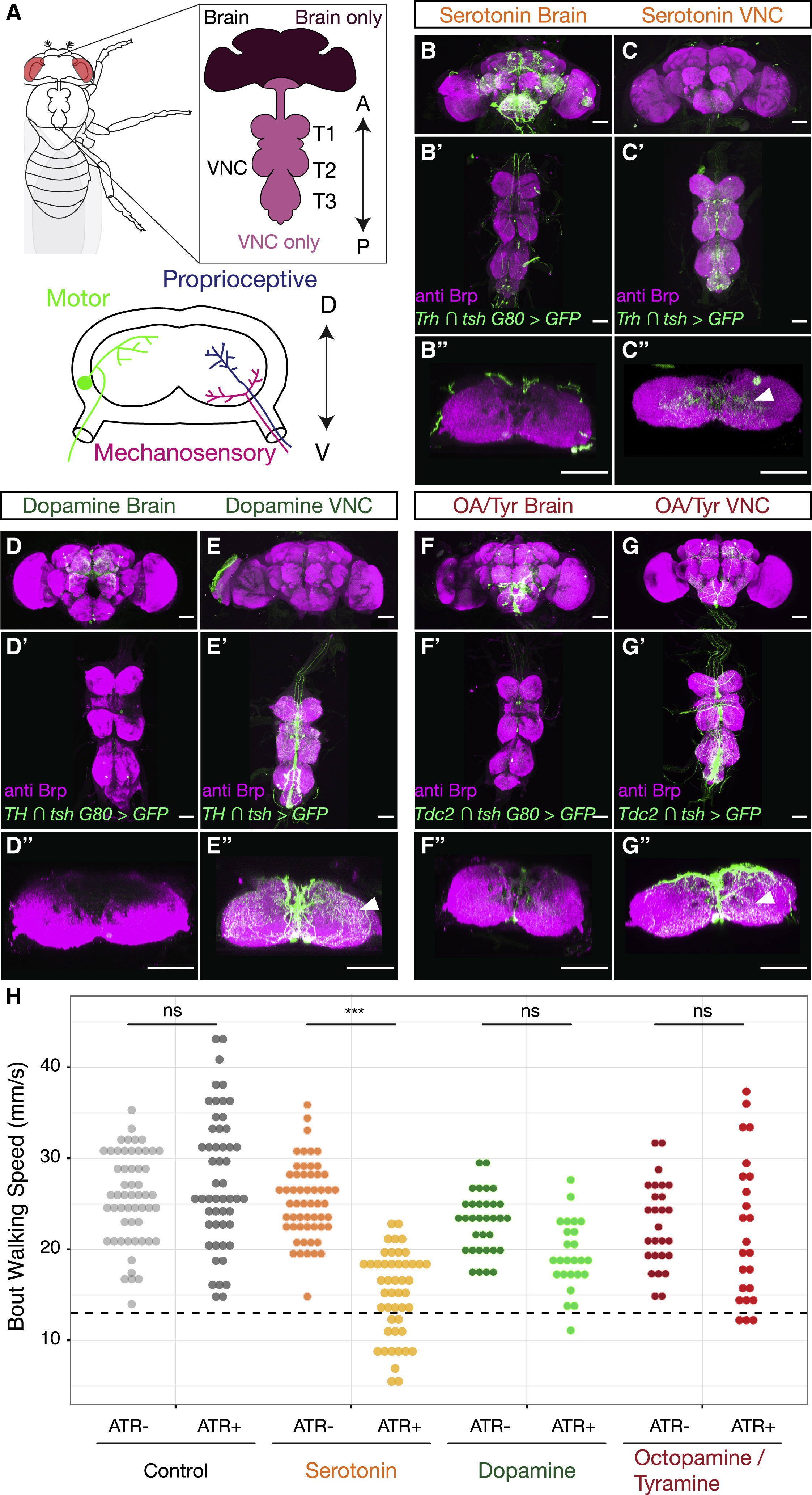
Image No. 1: neuromodulators in the central nervous system of Drosophila.
Curious and a little creepy fact - VNC is able to perform coordinated movements of limbs even in decapitated animals.
Thus, summing up the data of previous studies, it can be assumed that it is the VNC that contains neural networks that can coordinate the flexion and extension of each joint of each leg of the fly, as well as coordinate the gait itself.
Previously, it was found that for fast and stable locomotion, sensory data coming from the paws is extremely necessary. However, it cannot be argued that this is the only regulator, since even with the removal of proprioceptive receptors or damage to the limbs, coordinated walking is not disturbed. Therefore, there is something else that regulates it. But what?
Scientists believe that these hidden regulators may be neuromodulating systems, which include dopamine, norepinephrine and serotonin.
Neurotransmitter * - a substance with which an electrochemical impulse of a nerve cell is transmitted between neurons, as well as an impulse from neurons to muscle tissue or glandular cells.
Dopamine * is a neurotransmitter that is usually associated with a feeling of satisfaction and love, as well as cognitive functions (switching attention from one stage of cognitive activity to another). Human diseases associated with dopaminergic deficiency include Parkinson's disease.
Norepinephrine * is a neurotransmitter that is commonly associated with wakefulness. In the human body is involved in the regulation of blood pressure and peripheral vascular resistance. Norepinephrine is also involved in the “fight or flight” reaction when the body is in danger.
Serotonin * is a inhibitory neurotransmitter, i.e. Dopamine antipode (activating neurotransmitter). Serotonin causes a smooth muscle contraction and facilitates motor function, regulates vascular tone. Also, serotonin is often called the "hormone of happiness", which is a rather crude and inaccurate statement.It is worth noting that the same neuromodulating systems perform very similar functions in different animal species. For example, serotonin slows down motor rhythms in lampreys, cats, and locusts (the most unusual trio I've seen). A study of Drosophila showed that their monoamine neurotransmitters * also modulate a wide range of behavior.
Monoamine neurotransmitters * are neurotransmitters and neuromodulators having one amino group, which, through a chain of two carbon atoms, is connected to an aromatic ring (-CH2-CH2-).It was found that serotonin affects the decrease in walking speed, modulates sleep, aggression and motor behavior associated with anxiety. But dopamine, on the contrary, is associated with hyperactivity. Another interesting neurotransmitter is octopamine, which has been shown to affect the hyperactivity caused by starvation. In the absence of octopamine, animals moved more slowly.
As we can see, the simple crawling of a fruit fly on walls or the ceiling is associated with many complex neurochemical processes, which scientists decided to study in more detail.
Research results
To identify neuromodulating neurons that may play a role in modulating walking behavior, scientists used the expression of a fluorescent reporter * with Gal4 under the control of promoters * encoding key synthetic enzymes for each neuromodulating system:
- tryptophan hydroxylase (Trh) for serotonin (5-HT);
- tyrosine hydroxylase (TH or ple) for dopamine;
- tyrosine decarboxylase 2 (Tdc2) for octopamine and tyramine.
Reporters * are genes that attach to the regulatory sequences of other genes to study the manifestations of genes in cell cultures.
Promoter * is a DNA nucleotide sequence that plays an important role in the process of transcription initiation (RNA synthesis, where DNA acts as a template).All of these mediators exhibit extensive expression in both VNC and brain cells.
The scientists further checked whether the paw neurons are innervated by * neuromodulatory VNCs or descending neurons originating from the brain ( 1A ).
Innervation * - supply of organs and tissues with nerves, which ensures their connection with the central nervous system.Experiments have shown that the neuromodulating innervation of the neuropil paws occurs almost entirely from * VNC interneurons , and not from descending neurons in the brain ( 1B - 1G ).
Interneuron * (an intermediate neuron) is a neuron connected only with other neurons.Therefore, it is the VNC neuromodulatory neurons that can theoretically strongly influence locomotion. At the next stage of the study, scientists checked whether there are enough neuromodulating neurons in the VNC only to modulate walking behavior. These neurons were optogenetically activated, and walking speed was measured using a Flywalker behavioral analysis.
The analysis showed that activation of exclusively serotonergic VNC populations (i.e., without activation of dopaminergic or octopaminergic / tyraminergic) significantly reduced the average speed of midges ( 1H ). Based on this observation, the scientists decided to focus all their attention only on serotonergic neurons (5-HT VNC ).
To confirm the theory of serotonin and exclude the influence of other neurotransmitters, immunostaining was performed on markers of serotonergic (5-HT), dopaminergic (TH), octopaminergic / tyraminergic (Tdc2), glutamatergic (VGlut), cholinergic (ChAT) and GABA.
Experiments have shown that the Trh-Gal4 line controls expression in 5-HT-expressing neurons and that these neurons do not express any of the other neurotransmitters listed above. Therefore, exclusively serotonergic neurons are present.
Next, practical experiments were carried out, where scientists observed insects freely moving through the chamber, which made it possible to characterize the effect of 5-HT VNC neurons on motor functions.
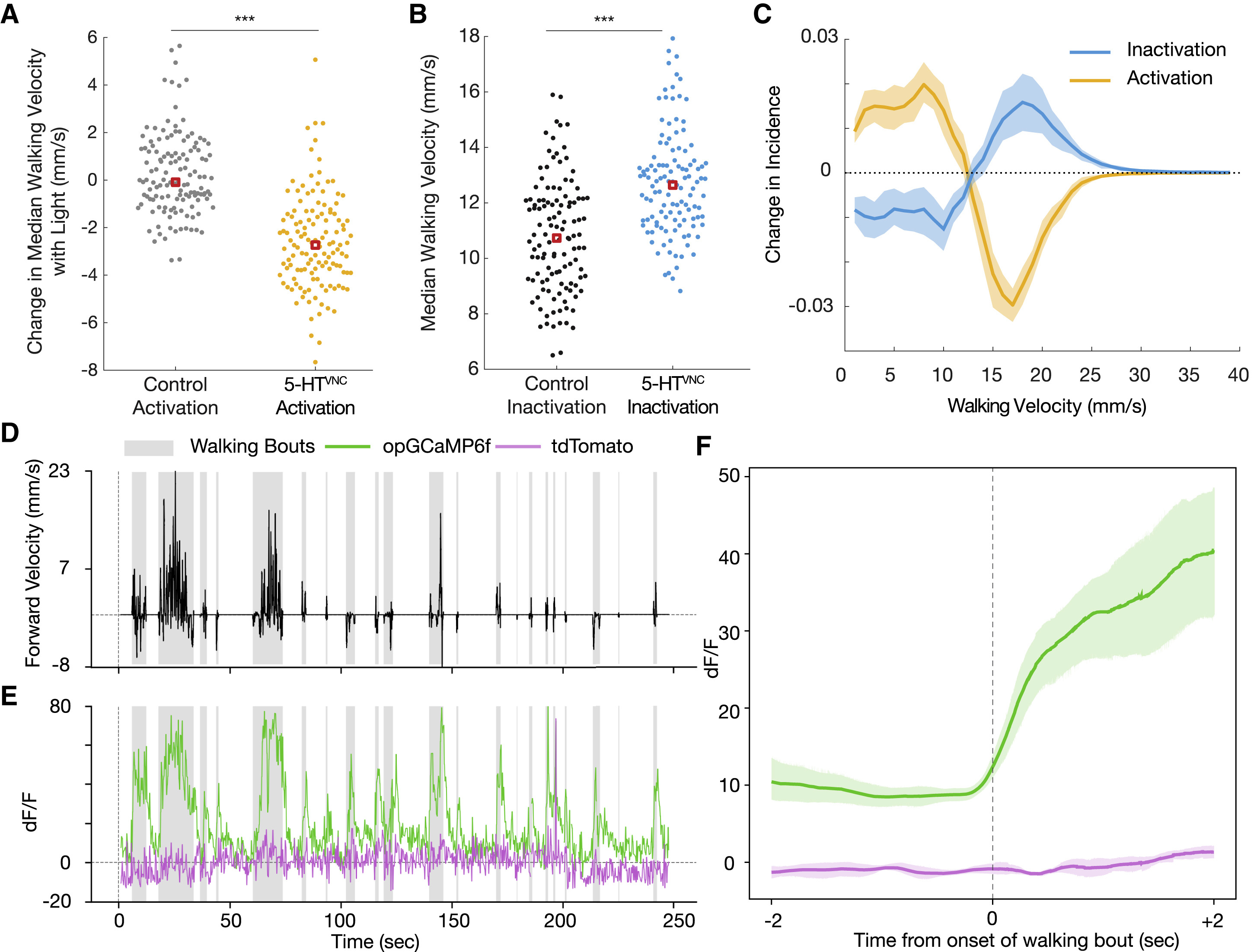
Image 2: 5-HT VNC neurons modulate the speed of Drosophila walking.
As expected, the activation of 5-HT VNC neurons was sufficient to lower the average walking speed ( 2A ). It is curious that the activation of these neurons does not change the total walking time of the experimental subjects. This suggests that it is not the individual’s overall activity that changes, but namely the average speed of movement (walking).
It has also been found that activation of 5-HT VNC neurons reduces the absolute angular velocity of flies. That is, experimental individuals walk more slowly, but along more direct paths than midges from the control group.
Scientists note that this research method, although it shows a decrease in speed due to the activation of 5-HT VNC neurons, but it cannot show in what situations in real life (in the natural environment) these neurons are usually used to modulate locomotion. To find out, potassium internal rectification channels * Kir2.1 were used to constitutively inactivate 5-HT VNC neurons.
Internal rectification channels * are ion channels through which positive ions easily pass into the cell, but not out.Inhibition (ie, “disconnection”) of 5-HT VNC neurons causes midges to go faster (2B), which once again confirms previous experiments. In fact, speed shifts caused by either optogenetic activation or constitutive inhibition of 5-HT VNC neurons are opposites of each other ( 2C ). In addition, the inactivation of 5-HT VNC causes experimental subjects to increase their angular velocity, and also increases the percentage of time that the midge spends when walking.
Therefore, the mutual influence on the rate of activation or inactivation of 5-HT VNC neurons suggests that the release of serotonin in VNC is able to modulate the baseline walking speed.
From the above observations, it follows that the activation / inactivation of 5-HT VNC neurons will vary during midge movement. To test this, the midge was placed on the treadmill (no, this is not a joke) and a functional calcium imaging of the 5-HT VNC ( S3A ) processes was performed .
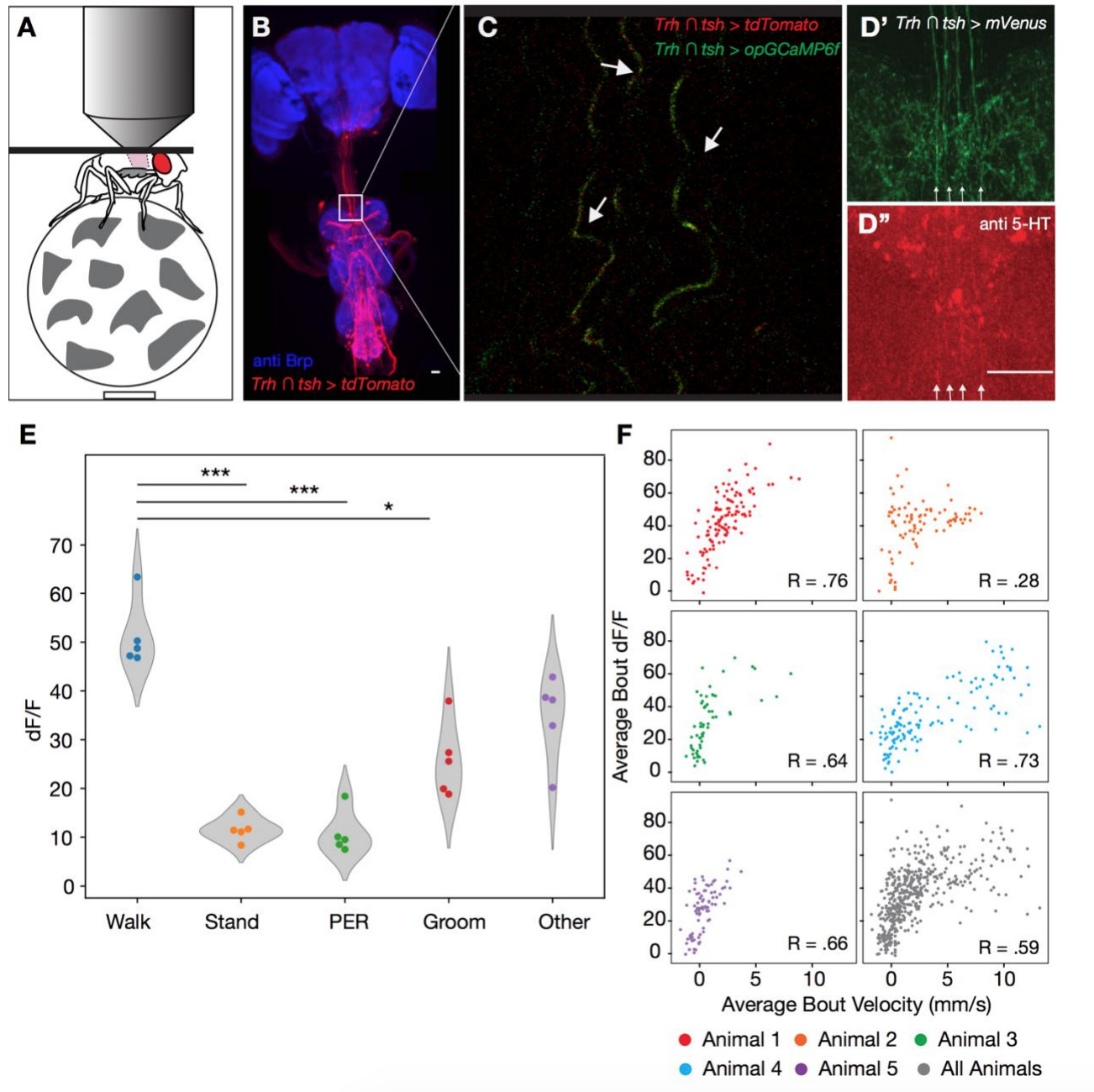
Image No. S3 (from additional materials): visualization of 5-HT VNC neurons in a moving midge (refers to image No. 2).
The analysis was carried out not of the whole body, but of fibers in the cervical junction, since activity in these fibers is closely related to walking ( 2D and 2E ). The fluorescent calcium signals from these cells increase sharply at the beginning of each “walk” along the treadmill ( 2F ). These signals are much weaker when midges perform other movements, such as proboscis or “washing”. These observations suggest that a subset of 5-HT VNC neurons are active during walking, and not during any movements in general.
It was also found that the activity of these serotonergic processes positively correlates with the average walking speed. Therefore, these neurons can become more active when an individual goes faster.
However, it can be assumed that the slowing of walking speed upon activation of 5-HT VNC neurons may be due to impaired coordination of movements.
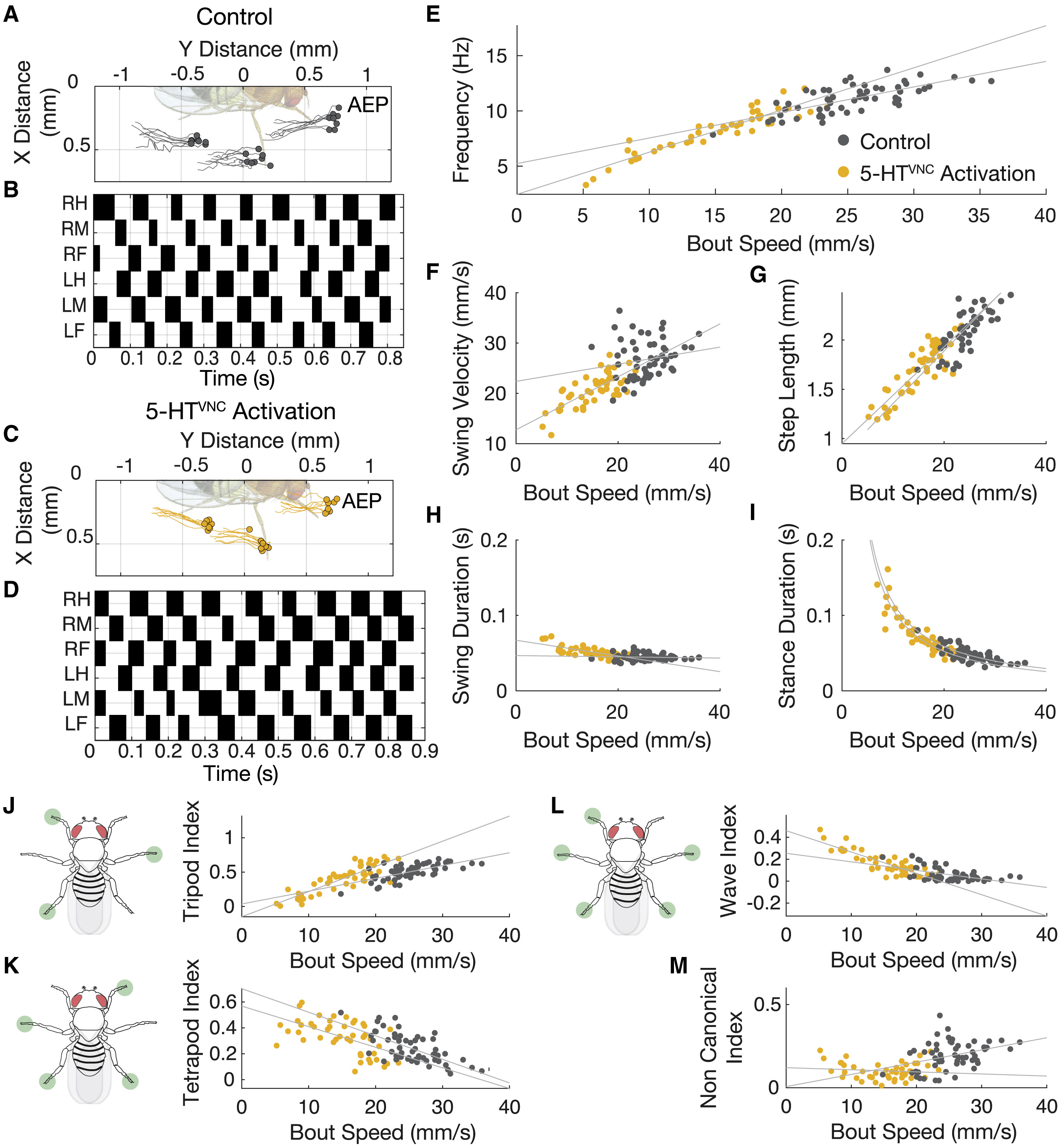
Image 3: movements continue to be coordinated when 5-HT VNC neurons are activated.
Otherwise, slowing down and activating 5-HT VNC are not associated with coordination. Check which option is correct by analyzing Flywalker data.
The results of the analysis showed that the activation of 5-HT VNC is not only not a consequence of a coordination disorder, but quite the opposite. The fact is that with slower walking, greater coordination of movements is required, which was found in midges during experiments ( 3A and 3C ). The way midges move each of the legs while walking fully confirm the absence of any coordination disorders ( 3B and 3D ). By the way, midges from the control group (in which nobody activated anything extra) just the same showed less coordinated movements than midges with activated 5-HT VNC neurons.
It is important to take into account the fact that the parameters of coordination of movements and the parameters of walking cannot be constant in all cases, since they constantly change depending on the speed of the animal. For example, when animals walk slower, the frequency of their strides decreases, they take longer strides and slow down the speed of their swaying (i.e., at the moment of making the stride) paws. Such parameter shifts are accompanied by shifts in a step-by-step cycle, since the duration of the stand (of a separate position of the body during walking) increases, and the duration of the oscillation remains basically unchanged.
When 5-HT VNC neurons are activated, these relationships remain relevant and extend to a range of slower speeds ( 3E - 3I ). When the midge slows down, it predominantly uses 4 legs for support (a more stable option), while three are used for a quick step. After activating the 5-HT VNC neurons, the experiment continues to use just such a gait ( 3J - 3L ).
In some cases, such as stride length ( 3G ) and stance duration ( 3I ), the relationship between motion parameters and speed upon activation of neurons is an extrapolation of the corresponding ratio in wild midges. But in the case of choosing a gait using a support of three legs ( 3J ), the ratio of parameters and speed changes when these neurons are activated. In other words, the stride length and the length of an individual position during walking when 5-HT VNC is activated is comparable to ordinary midges, and in the case of a tripod type of gait, the parameter-speed ratio changes.
As it has already become clear, the serotonergic system is used to regulate walking speed: when the system is activated, midges go slower, and when the system is inactivated, midges go faster. Following this statement, scientists decided to check whether this system is needed to adjust the basic walking speed in a natural way.
To verify this, several experiments were carried out when 5-HT VNC neurons were inactivated, and the midges stayed at different speeds (temperature changes, orientation of the body position, food availability and mechanosensory stimulation).
Curiously, all experimental subjects with inactive 5-HT VNC neurons continued to successfully regulate their speed ( 4A ).
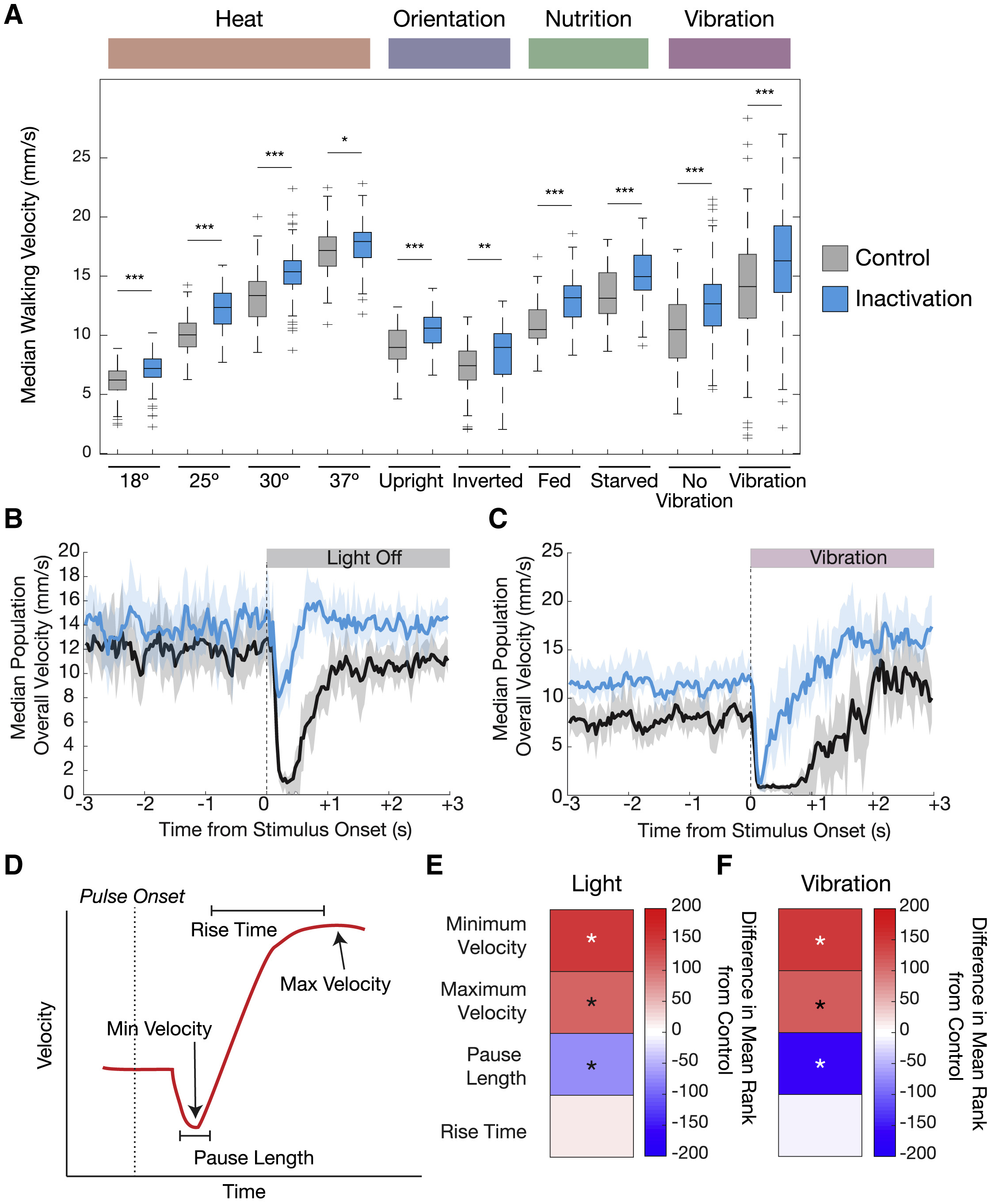
Figure 4: Changes in walking parameters when 5-HT VNC neurons were inactive.
It was found that in all tested conditions, subjects in which 5-HT VNC neurons were inactive go faster than the control group. For example, flies go slower at 18 ° C and faster at 30 ° C, even when 5-HT VNC neurons are disconnected.
Thus, the release of serotonin in VNC slows down walking speed in a wide range of environmental conditions. These results are consistent with a model in which the serotonergic VNC system acts as a soft and constitutive modulator of walking speed, regardless of how quickly or slowly this speed is set by other mechanisms.
The most curious observation was that inactivation of 5-HT VNC neurons affects the response of midges in response to abrupt changes in the environment. Although the above results show that the serotonergic VNC system is not needed for midges to adjust baseline walking speed in many situations, fear is a rather unique situation that needs to be studied.
In mammals, the classic behavior of fright occurs in response to a wide range of sensory stimuli - acoustic, tactile, vestibular, etc. These reactions are incredibly fast and include simultaneous contraction of muscles throughout the body. Like mammals, Drosophila exhibit a classic behavior during a fright - freezing for a split second, and then a saving retreat.
To test the connection between fading, serotonin, and the activity of 5-HT VNC neurons, several experiments were carried out in two scenarios: sharp darkness and sharp vibration. In both scenarios, the subjects demonstrate two behavioral reactions ( 4B , 4C, and 4D ): first, many of their individuals freeze almost completely (for 0.25 seconds), then a short pause (about 1 second) follows, and then the midge begins to act in accordance with new circumstances.
Consequently, the serotonergic system not only serves as a constitutive factor in changing locomotor speed, but also is a modulator of fading, regardless of the stimulus that caused fright in the midge.
Researchers recall that all five Drosophila serotonergic receptors - 5-HT1A, 5-HT1B, 5-HT2A, 5-HT2B and 5-HT7 - are G-protein bound receptors (GPCR). All of these receptors can have different effects on locomotion and response due to fear.
Individuals with the 5-HT1A Gal4 , 1B Gal4 , 2A Gal4, and 7 Gal4 receptors spend more time walking, however, walking speed increases only in individuals with 5-HT7 Gal4 ( 5A ). It follows that 5-HT7 is the main receptor responsible for the indirect effect of serotonin on walking speed.

Image No. 5: Effect of serotonergic receptors on locomotion parameters.
Next, the effect of receptors on the situation with sharp vibration was checked. 5-HT7 Gal4 and 5-HT1B Gal4 almost completely copy the fading reaction observed with Trh01, as well as in experiments on the inactivation of 5-HT VNC ( 5C , 5D and 5G ). But 5-HT1A Gal4 and 5-HT2A Gal4 do not show a sharp change in the duration of the pause, but demonstrate a steady decrease in the final speed of the individual in response to an external stimulus ( 5E - 5G ). From these observations, it follows that different receptors lay on different aspects of the fright reaction.
For a more detailed acquaintance with the nuances of the study, I recommend that you look into the report of scientists and additional materials to it.
Epilogue
In this study, it was shown that serotonin has a direct effect on locomotion, as well as on the fright reaction. Scientists believe that serotonin at the time of fright acts as an emergency system that causes tissue contraction in the extremities of the midge, which causes a subsequent short pause before the movement begins. This pause can play an important role, because at this moment the nervous system can collect additional information about the stimulus that caused the fright, and decide how to proceed.
Experiments were carried out on Drosophila, however, the observation results can be used to analyze chemical and molecular processes in other animals, including humans, since serotonin and the numbness reaction are extremely widespread among animals of various species.
In the future, scientists plan to study in more detail the effect of serotonin on locomotion, as well as to establish other factors that in one way or another modulate the movements of animals. The main task for themselves, researchers call the creation of a complete molecular map of processes associated with locomotion.
Friday off-top:
You’re walking through the woods, don’t touch anyone, but here is your double.
You’re walking through the woods, don’t touch anyone, but here is your double.
Friday off-top 2.0:
Are you sure that wild animals do not like opera? (It was not possible to make an insert with the video right here due to restrictions from the author of the video, but by clicking on the link you can watch it).
Thank you for your attention, stay curious and have a great weekend everyone, guys! :)
A bit of advertising :)
Thank you for staying with us. Do you like our articles? Want to see more interesting materials? Support us by placing an order or recommending to your friends cloud-based VPS for developers from $ 4.99 , a unique analog of entry-level servers that was invented by us for you: The whole truth about VPS (KVM) E5-2697 v3 (6 Cores) 10GB DDR4 480GB SSD 1Gbps from $ 19 or how to divide the server? (options are available with RAID1 and RAID10, up to 24 cores and up to 40GB DDR4).
Dell R730xd 2 times cheaper at the Equinix Tier IV data center in Amsterdam? Only we have 2 x Intel TetraDeca-Core Xeon 2x E5-2697v3 2.6GHz 14C 64GB DDR4 4x960GB SSD 1Gbps 100 TV from $ 199 in the Netherlands! Dell R420 - 2x E5-2430 2.2Ghz 6C 128GB DDR3 2x960GB SSD 1Gbps 100TB - from $ 99! Read about How to Build Infrastructure Bldg. class c using Dell R730xd E5-2650 v4 servers costing 9,000 euros for a penny?